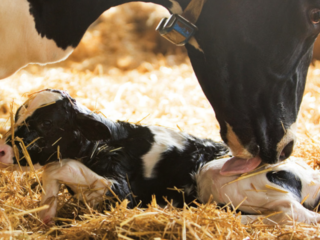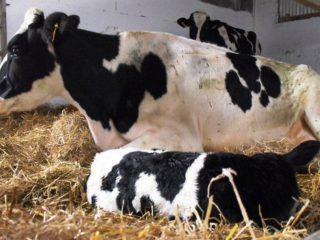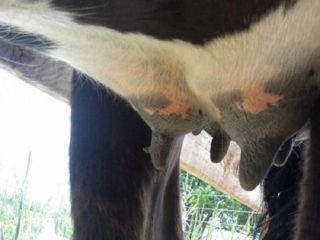Content
Paratuberculosis in cattle is one of the most insidious and dangerous diseases. It not only brings economic losses. Other domesticated herbivorous artiodactyls are also susceptible to the disease. But the main problem is that a person may also be infected with paratuberculosis.
What is paratuberculosis
Other names: Yone's disease and paratuberculous enteritis. This chronic bacterial disease is characterized by recurrent diarrhea, productive enteritis, gradual exhaustion and subsequent death of the animals. The causative agent of the disease is the bacterium Mycobacterium avium paratuberculosis subspecies.
Susceptible to bacteria:
- Cattle;
- sheeps;
- buffalo;
- camels;
- goats;
- deer;
- yaks.
The ranking of animal species is based on the decrease in the level of susceptibility to bacteria.
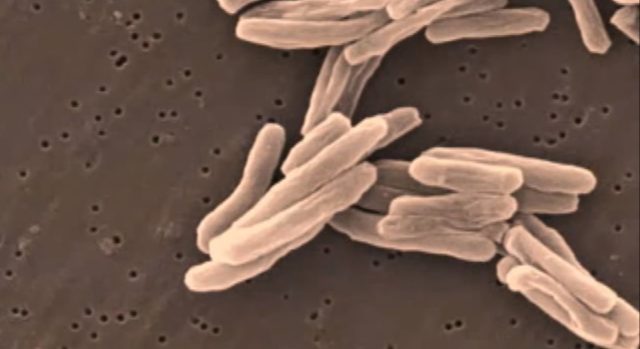
The causative agents of cattle paratuberculosis under a microscope
The bacteria Mycobacterium avium is common in almost all countries with intensive livestock production. Microorganisms are well preserved in soil and manure - up to 10-12 months. In stagnant water bodies and feed, bacteria remain viable for 8-10 months.
Mycobacterium avium bacteria are also very resistant to disinfectants. The best drugs for disinfection in case of an outbreak of paratuberculosis:
- formaldehyde;
- xilonaft;
- freshly slaked lime;
- cresol;
- caustic soda.
All drugs are poisonous to humans.
Most animals either do not get sick, or livestock becomes a latent carrier of paratuberculosis. Mortality due to infection with Mycobacterium avium is only 1%. But this 1% includes all livestock of cattle showing obvious clinical signs. The rest of the disease is dangerous because it reduces the productivity of animals.
In humans, similar signs are observed, but the possibility of infection with cattle paratuberculosis is still in question. This problem has not yet been fully understood. It is possible that another disease causes similar symptoms.
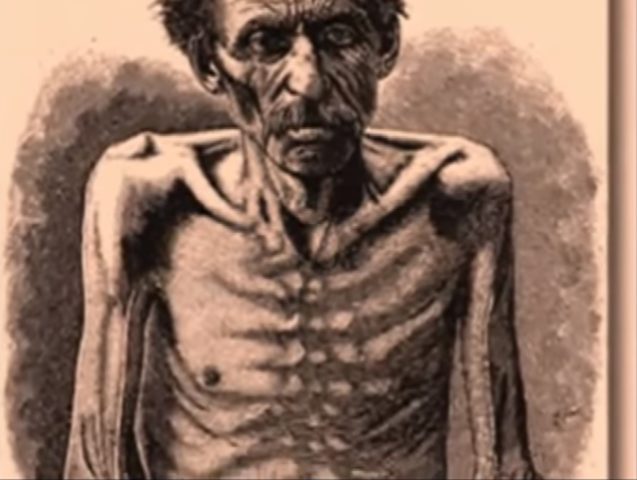
A person infected with paratuberculosis in the last stage of the disease
Sources and routes of infection
The source of infection is a sick animal. Private owners need to be especially careful, as the bacteria is easily transmitted from one artiodactyl species to another. The source of infection is the feces of a sick animal. Paratuberculosis in cattle develops slowly, and an apparently healthy animal may in fact already be a carrier of infection.
Most often, infection occurs in the first year of life. The calf swallows bacteria in the mother's milk or manure particles if the cattle are kept in unsanitary conditions. Cleanliness in foreign cowsheds is not due to high culture. Manure, just dried on the thighs of a cow, is a breeding ground for pathogenic bacteria. Intrauterine infection is also possible.
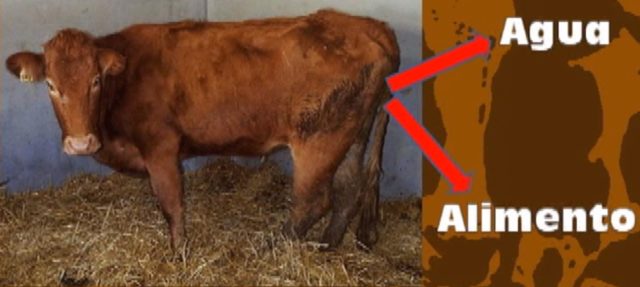
A clear illustration of the ways of spreading the infection: the feces of a sick animal get into water and hay
Cattle are most susceptible to paratuberculosis in the first year of life. But signs of the disease appear only 2 or more years after infection. If a cow becomes infected with paratuberculosis at an older age, it will definitely not show clinical signs until 2 years after infection. The same applies to a calf that has received a small dose of paratuberculosis pathogens.
Provoking factors:
- decreased immunity due to inadequate feeding;
- helminths;
- hypothermia;
- overheating.
All this can be attributed to inappropriate conditions of detention.
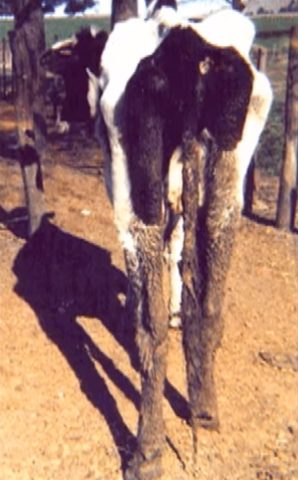
In the second stage of the disease, diarrhea is liquid, and the animal has significantly lost weight
Symptoms of paratuberculosis in cattle
The main signs of Mycobacterium avium infection in cattle are diarrhea and wasting. Moreover, usually the clinical manifestation of symptoms occurs at the age of 2 to 6 years, although cattle become infected in the first year of life, and even in the womb.
At the first stage, the signs of paratuberculosis are poorly expressed. They can be expressed in weight loss, decreased productivity and slight tousling of the coat. The cow defecates more often than normal, but the manure is rather thick, without epithelial debris, blood or mucus. Periodically, the work of the gastrointestinal tract returns to normal.
A few weeks after the onset of diarrhea in cattle, the soft tissues of the lower jaw swell. This symptom is known as bottle jaw or intermaxillary edema. Edema is caused by the withdrawal of protein from the bloodstream as a result of disruption of the gastrointestinal tract.
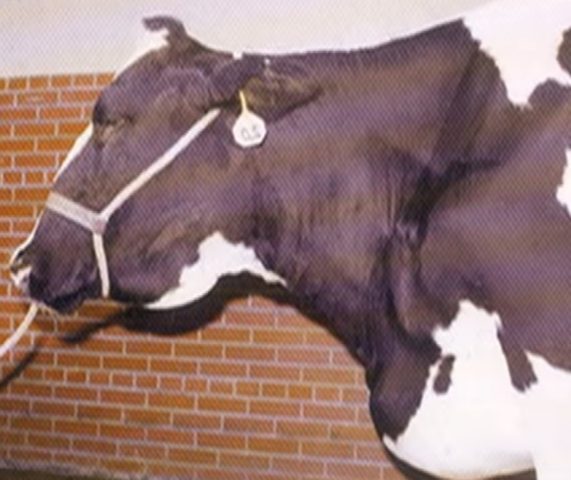
Swelling of soft tissues under the lower jaw and on the dewlap in cattle paratuberculosis
With further progress of the disease, cows lose more and more weight. Death occurs as a result of dehydration and severe cachexia.
Symptoms of dehydration
Dehydration is the loss of water by the soft tissues of the body as a result of metabolic disturbances. In paratuberculosis, dehydration occurs as a result of diarrhea. When soft tissues lose more than 25% of water, the animal dies.
Dehydration is accompanied by:
- thirst;
- oppression;
- a decrease in the amount of urine;
- convulsions;
- with a pinch test, the skin fold does not straighten for a long time;
- the coat is dry, tousled;
- nasolabial speculum dry.
Dehydration in cattle paratuberculosis occurs already at the last stage of the disease.
Cachexia
Outwardly, it does not differ from dehydration, but with cachexia, the animal does not lose water. With this phenomenon, cattle lose weight. Muscle atrophy and weakness are observed. But a pinch test does not show dehydration. However, with paratuberculosis, cachexia and dehydration are combined.

Appearance of cattle with paratuberculosis at the second stage of the disease
Diagnosis of the disease
Symptoms of paratuberculosis coincide with signs of other diseases and even non-infectious diarrhea caused by an improper diet. Paratuberculosis must be differentiated from:
- strongyloidosis;
- coccidiosis;
- tuberculosis;
- alimentary diarrhea.
The diagnosis is made taking into account the epizootic data in the region.
Diagnostics is carried out by 2 methods:
- serological;
- allergic.
With serological, serum is made from the blood of suspicious individuals, after which an analysis is carried out using the RSK. The detection rate of sick animals is 85%.
With the allergic method, there are two ways to check: altuberculin for birds and paratuberculin. In the first case, 80% of sick individuals show a positive reaction, in the second - 94%.
Allergic diagnostics are performed using an intradermal test. The reaction is checked after the first injection after 48 hours. With a positive reaction at the injection site, edema appears without strict boundaries and configuration, measuring approximately 4x11 cm or more. The local temperature at the site of the tumor is increased. Edema along the edges of the dough, hard in the center. The injection site is painful.
If suspicious individuals give a dubious reaction, the sample is repeated. The result is checked one day after the injection.
It is not only the lymph nodes and parts of the intestines from slaughtered and dead animals that are sent to the laboratory. Also, feces with scraps of mucous membrane and lumps of mucus are sent there for bacteriological examination.
Treatment of paratuberculosis in cattle
There is no cure. Even the impact of the vaccine is questionable. All animals diagnosed with paratuberculosis are slaughtered.These requirements even apply to calves born from sick cows.
Prophylaxis
Since healthy livestock becomes infected with paratuberculosis from sick individuals, measures are taken to prevent unnecessary contact and increase the individual resistance of the cattle organism to the paratuberculosis pathogen.
Zoo hygiene is observed: animals of different species, susceptible to the disease, are kept in separate buildings. The distance between the farms must be at least 100 m. Cattle and small cattle are not allowed to joint grazing.
Research for paratuberculosis is regularly carried out. Cattle with a positive allergic reaction to the RSK sample are sent for slaughter. Calves under the age of 10-18 months, who reacted twice to tuberculin, are also determined there.
For humans, the main preventive measure is the use of only pasteurized milk. Farm workers must keep their clothes clean and disinfected in time.
They also carry out systematic disinfection of the barn (whitewash of walls) and treatment of inventory and equipment with disinfectant solutions.
Conclusion
Since paratuberculosis in cattle and other artiodactyls is incurable, you should not hide sick animals from veterinary services. One sick animal can infect all other livestock in the area. In the event of an epizootic outbreak, veterinary services will destroy all susceptible animals in the region. This will cost more than the slaughter of one diseased individual.


